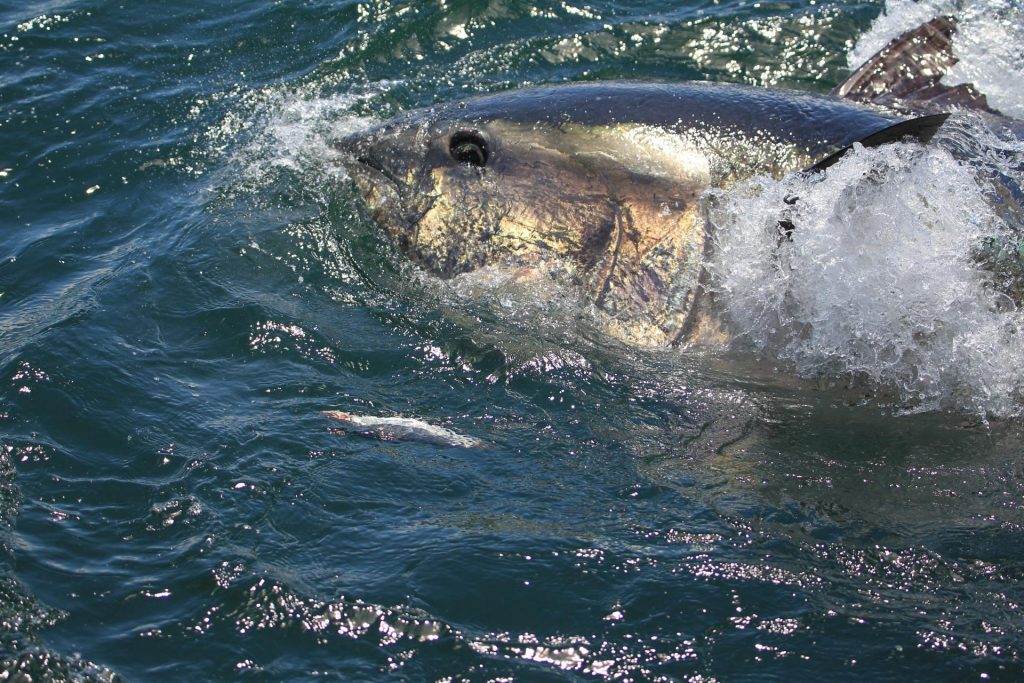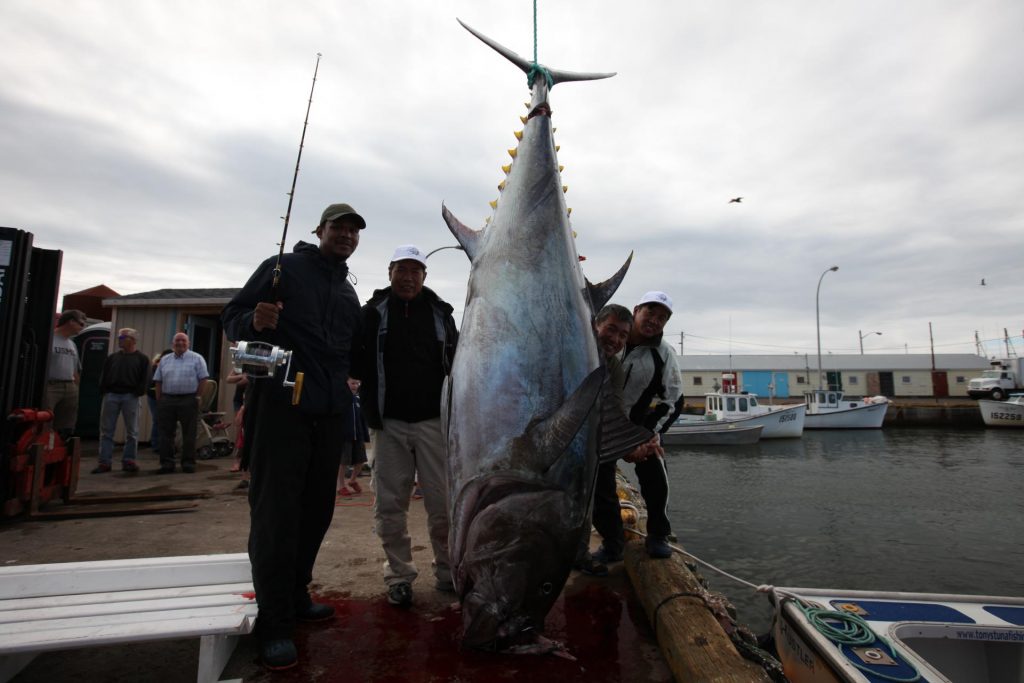It was like waking up from a dream. Three decades of fishing flashed before me as I looked over the rail and locked eyes with the silver giant laying on its side at the ocean surface.

After a two-and-a-half hour fight, there wasn’t enough time for a photo op before the deckhand cut the leader and my trophy slipped back into the blue. The funny thing was I didn’t even care. In that instant every bit of the “fishing jones” in my soul cathartically evaporated and left me more at peace than I could ever remember. I chuckled to myself, “Ha, now I can die.”
Not long ago I came up with a T-shirt design, jokingly illustrating the “staircase of fishing addiction,” in which the afflicted saltwater angler progresses from the easy coastal species to more challenging pelagics.
As he ascends the staircase, he engages in an increasingly relentless pursuit of bigger and bigger quarry located in the most remote watersheds around the globe. People who can continuously fish at this level are usually independently wealthy, or just plain crazy and willing to go at it with reckless abandon, no matter the consequences.
For all anglers there is an apex, a target at the very top of the staircase, over which they obsess. For game fish, this Holy Grail that will push anglers over the edge is, without a doubt, thunnus thynnus, the majestic northern bluefin tuna.
Until recently the number one item on my bucket list had been landing a giant bluefin weighing more than 400 kilograms on standup tackle. When I first told some inshore fishing buddies what I was going to do, they laughed in my face, having never heard of such an absurd notion. What I knew was, not only was it possible, but there’s no greater fight to be had in big game fishing.
As a lure angler, I was first introduced to targeting bluefin on top water spin gear, which most experienced anglers will tell you is suitable for fighting tuna weighing upwards of 70 kilograms. This tackle is probably the most exciting means of landing tuna, but it will kick the crap out of anyone not in shape. A few die-hard types actually do weight training in the run up to tuna season, just in case they hook a 100-plus-kilogram fish that can take all day to get to the boat.
I toiled away tossing plugs for several seasons thinking about this 100 kilograms leviathan, but it eventually dawned on me the biggest tuna I could hope to land on such light tackle was basically a guppy.
For many top water anglers, myself included, the first giant tuna caught on standup gear changes the ball game. The full glass rods and size 80 trolling reels used for standup fishing are bulkier and heavier than spinning tackle but capable of sustaining much greater torque loads. The angler wears a specially designed harness which evenly distributes pressure across the quadriceps, making the fight a matter of squatting and cranking only.
Needless to say, tuna fishing is popular in Japan, but access to the best grounds in the country is usually granted exclusively to artisanal fishermen belonging to commercial cooperatives. Instead of the fisheries agency, the co-ops are largely in charge of managing the resource themselves, although some will point out rules banning the use of long lines and purse seines are routinely ignored by dodgy fishermen in search of a quick buck.
The one place recreational and commercial fishermen seem to have it right is the Genkai Sea off northern Kyushu. In these waters, skilled anglers can land tuna weighing well over 100 kilograms if they are guided by good skippers who know the best points, bait patterns and presentation methods.
If Kyushu doesn’t do it for you, another option is southern New Zealand where live-aboard charters will take you several hundred miles offshore in search of commercial hoki trawlers. Massive schools of giant tuna weighing upwards of 300 kilos converge on these vessels as they haul in their nets to feed on hoki that fall through the mesh. A standup fight in New Zealand can take hours, as the fish can swim fast and deep, giving any angler who brings one to the boat the impression he’s taken it to the limit.
Not quite.
The International Game Fish Association (IGFA) world record bluefin tuna weighed in at 1,496 lbs. (678 kgs.), caught off Prince Edward Island (PEI), Canada, in 1979. PEI is the bluefin capital of the world where the small tuna weigh in excess of 300 kilograms. It’s not only their size that is amazing, but also their numbers, and the ease with which an angler can hook one.

The grounds are less than two miles from shore in water between 30 and 40 meters deep, and the bluefin feed readily right at the side of the boat. The stock is so healthy some off-season lobster fishermen take groups of tourists on tuna-watching tours. This is perhaps a glimpse of what the rest of the world’s tuna fisheries looked like 60 years ago before man decimated them.
The giant bluefin found off PEI are the breeders of the western Atlantic stock and are big and plentiful because they are protected by strictly enforced regulations in both Canada and the United States. These regulations are established annually based on peer reviewed research and are considered the model for sustainable fisheries management around the world.
Conservation minded readers might gasp at the notion of pursuing bluefin tuna for sport given the scientific community’s consensus the species is critically endangered in the eastern Atlantic and western Pacific. Before you dispatch a cabal of Sea Shepherd commandos to my house, bear in mind sport anglers witness the fragile state of fisheries around the globe first hand and most strongly advocate taking any necessary steps to help the biomass of tuna rebound.
It may sound extreme but, for my peers and me, the best case scenario would be an outright commercial trade ban. As much as I’d like to eat toro sashimi in good conscience, it’s clear commercial fishing interests the world over are too corrupt and shortsighted to be trusted, and most governments are not willing to come up with an appropriate or enforceable regulatory framework.
Since a total ban is hardly likely in the near future, the fate of the species is in the hands of consumers who can demand transparency throughout the supply chain and have the option of not buying tuna taken using unsustainable methods. In this sense, Japanese consumers are the most capable of protecting the bluefin from extinction given that 80 percent of the fish harvested worldwide ends up in Japan.
I’m pretty sure my fish did not quite weigh 400 kilos, but catching and releasing a giant bluefin was as good as big game fishing gets. I’m encouraging my friends to give it a whirl but am personally satisfied to the point where I’d be happy if I never did it again. I’m just hoping there will still be some giants left when my daughter is old enough to fight one.
Getting on the Fish
Anglers interested in making the trek to Canada can contact PEI’s best skipper, Capt. Tony MacDonald.
Yoichi Mogi is Japan’s and, quite possibly, the world’s most active offshore fisherman, taking expeditions to the farthest reaches of the globe.





